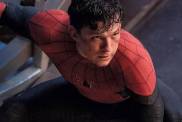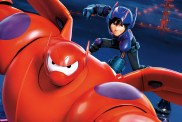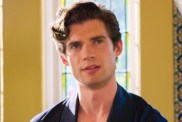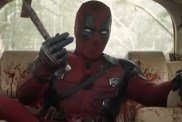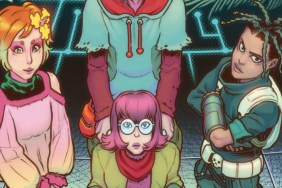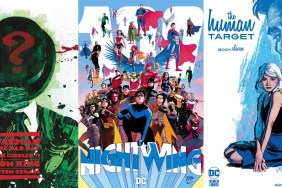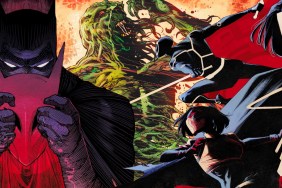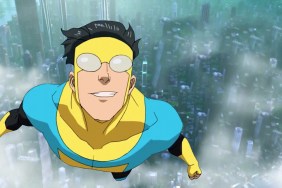Excerpt From See You At San Diego: An Oral History of Comic-Con
In the past few decades, San Diego Comic-Con has grown far beyond its comic book roots. Over time, the biggest comic book convention in the country grew to become a pop culture event that drew thousands of fans from across the world…and attention from the Hollywood studios. Next week, Fantagraphics is publishing See You At San Diego: An Oral History of Comic-Con, Fandom, and the Triumph of Geek Culture. As the title implies, author Mathew Klickstein has assembled an oral history of Comic-Con from the men and women who made it what it is today. And in Superhero Hype’s exclusive excerpt from the book, we see the beginning of the show’s transformation into a destination for superhero, sci-fi, and fantasy films and TV shows.
Roger Freedman: As a scientist, I will say I’m super excited to think about the fact that the animation studios — for instance, Dreamworks — has a “head scientist” who has a PhD in Applied Mathematics from Harvard, who works with all these computer tools that actually make the physics turn out right. So, when you’re looking at a movie — for instance, How to Train Your Dragon, where you see the dragon actually doing an inside loop, with Hiccup riding on the back of it — the aerodynamics are actually correct. Or something as simple as a physicist from San Jose State University was hired by Dreamworks to make sure all the physics was correct, as well.
Even with something like Madagascar 3, there’s a scene where the zebra character that’s voiced by Ben Stiller is walking on a tightrope. There’s lots of visual references for bipeds walking on tightropes, but nothing for quadrupeds. So, how do you make that work? They actually hired a physicist to figure that out: How would the rope actually behave? And that’s done correctly in the film now. So, it’s exciting to me, as an animation fan, as a science fiction fan, and as a scientist, that all those worlds have come together and have led to this tremendous blossoming in all this popular media that I enjoy so much.
Joe Russo (Filmmaker): I remember being at Iron Man, and thinking at the time that VFX, visual effects, have reached a point where it felt photorealistic enough to me that a movie like that could be made and supported in the way that I didn’t study the VFX the entire time I was watching the movie or get pulled out of the film. Marvel really ushered that in. Without mainstream support, that would’ve never happened. So, I feel that, as a geek, as a comic book fan, I have to embrace and appreciate that aspect of it, because it’s what allowed my dreams to come true and be seen on the screen in a way that felt very real to me.
Scott Aukerman: That’s a big part of Comic-Con culture: special effects. The fact that a guy like Tom Savini is a superstar at Comic-Con is incredible, because he’s created these things that have so enraptured us. He should be famous! He should be just as famous as George Clooney, as far as I’m concerned!
Paul M. Sammon: I was the computer graphics supervisor on Robocop 2. So, I was not only someone writing about and watching all of this happen, but someone with over a decade of experience in the evolution of special effects. And from my point of view, it was very interesting to see how Comic-Con, again, was the Petri dish for so much of all of this.
Now, there was also the World Science Fiction Convention, which is a big deal, too. But Comic-Con was this eclectic group of people who were far more scattered in their interests than those attending Worldcon were for science fiction alone. At Comic-Con, you had and have all sorts of different kinds of people and fans coming together and often ending up working together to make so much of what we’re talking about here happen, even on a very technical, science-based level. Because those are the kinds of people Comic-Con attracts year after year.
Barry Alfonso: It was a confluence of a lot of things. Not only was it the faithfulness and the dedication of the Comic-Con people in the seventies, but it was all these changes in technology, too. Yes, the real demarcation point was Star Wars. The whole game changed when Star Wars came out, when fantasy films could be done that didn’t look ridiculous, that looked heroic. And then Close Encounters and on and on, and the Superman movie with Christopher Reeve. It became possible to make these movies that were serious looking. That was important, too. We at Comic-Con were encouragers of this, but we were also keepers of the flame. We kept the flame alive when it was not a big business to be into comic books, when it was a subculture. We had the faith and made it possible for it to take off later. How we individually made it take off, I’m not sure. I certainly didn’t. But collectively we prepared the launching pad. At the very least, we did do that.
Jim Valentino: In the early days, we had some guests come from what was out there as far as these comic book movies and TV shows, and that brought some fans into Comic-Con. But not like how it is today. And that doesn’t really get going until a few decades after Adam West’s Batman, for example.
Barry Short: By the time Michael Keaton’s Batman came around in 1989, I was a retailer. I had a comic book store in Orange County, California for about eighteen years. And people coming into the store were really excited about the new Batman movie. As a retailer, I can tell you that I was selling Batman merchandise — and a lot of it – when that movie was coming out. It was a huge boost to my business, and I’m sure to the business of many, many other comic retailers all over the country. The people who hopped on with Batman did just fine.
Which is funny to think about now, because it’s true that at first we were all confused when Michael Keaton’s casting was announced. It didn’t really make much sense to us. We were expecting somebody who was a little more beefy and a little more heroic, and Keaton at that point was basically kind of a “light comedy” actor. So, he wasn’t the guy that we expected to play Batman. And there was definitely a little bit of an uproar about that among the fans at first. But it turned out he was an okay Batman. And he was a fantastic Bruce Wayne, which made for a very interesting contrast.
And I think that contrast was part of some of the themes that Tim Burton was going for in the movie — that you really had to distinguish who this guy was in his day-to-day life versus who he was when he was Batman, that they were two very different aspects of the same person. I mean, you could believe that Adam West’s Bruce Wayne was Batman right away, because there wasn’t a great distinction between the two of them in the way that they interacted with people and the way that they looked, you know? Adam West’s Bruce Wayne and Adam West’s Batman were pretty similar guys.
Whereas Michael Keaton as Bruce Wayne and Michael Keaton as Batman are like two completely different people. You wouldn’t look at Keaton’s Bruce Wayne and say, “Wow, you remind me of Batman.” But you sure would with Adam West. So, it was an interesting take, and it took a while for us to adapt to it. But I think it ended up being brilliant.
Mark Evanier: When Tim Burton’s Batman movie was announced, there was a great excitement. Batman was going to get a high-budget major motion picture, and nobody knew what kind of movie it was going to be. And nobody knew who was going to play Batman. At that year’s San Diego Comic-Con, Adam West showed up, on his own. He came down and was running around the convention, trying to lobby people to demand that he — being the star of the sixties Batman television show — be cast in the role of “Batman.”
He wanted the job. His career, I think, was pretty cool at the time. And he saw himself as someone that the fans still thought was Batman. I don’t think he understood that a lot of comic fans thought that his Batman version was done with contempt for the character and contempt for our love of him, due to some of the campiness of the show. Adam West didn’t seem to understand at first that he was not going to be cast in the kind of movie that Tim Burton was planning to make. Tim Burton’s Batman was taking a complete shift, and it was kind of an anti-sixties-camp Batman movie. He was the wrong person for it.
Barry Short: Some of us were a little disappointed that he didn’t at least get a cameo of some kind. It seems like they ought to have been able to throw him a bone. But I don’t think that Tim Burton was necessarily interested in that. I think he was looking for a much cleaner break. Yes, in the Superman movie back in the seventies, you had Lois Lane’s parents played by Kirk Allyn and Noel Neill, who were the original Superman and Lois Lane in the serials.
So, you did have those nifty little cameos. But they weren’t really known at the time anymore, and they were such small characters, anyway. Not nearly as glaring as it would’ve been if Adam West had done a cameo in Burton’s Batman. They really were trying to make a break with the past, and to do something altogether new with Batman. Which meant, sorry: no Adam West.
Mark Evanier: I thought that Mr. West was a lovely man. He did a fine job doing the kind of Batman that the producers of the sixties show wanted to do. My view of that show was colored forever by meeting a few of those people behind the show and realizing how much contempt they did have for the character, for the premise, for anyone who would take the comic books as seriously as some of us did. And so, though I love the people in it – like Adam West, Julie Newmar, and Burgess Meredith, and so on – I never really liked the way the character was portrayed. I was glad to see somebody invert it and do something different with Batman, even though I actually didn’t even like what Tim Burton did with it either. But at least it wasn’t done with a kind of a snide view of the people who love Batman.
Barry Short: I have to say that, at least among the people that I was interacting with at that time, there was kind of an underlying feeling that Hollywood was trying to exploit us, as opposed to trying to appeal to us. Yes, there were always people at Comic-Con who were going to be excited that a big name director or a big name actor or actress was going to be there. That’s always going to be the case. Yes, it’s exciting they’re there so much now. I totally get it.
But I also think that, for a lot of us — especially the older folks who were there in the early days when this wasn’t really as much the case — there’s a little bit of cynicism about it now. Which can be disappointing when we think about all these Hollywood people coming more and more now to the Con. Mostly, we just ignore that and go on about the parts of Comic-Con that we love.
Jim Means: Now it’s sort of “flipped,” and everybody thinks of Comic-Con as a place to sell movies and television shows. It’s gone from being fan-driven to more studio-driven, you know? More corporate-driven these days. I think that’s what people are saying when they say, “Oh, I remember the days when it was just comic books and science fiction.” I think they’re thinking back to when it was their own love for those things that made it fun to go to Comic-Con. And now it’s different. It’s a spectacle.
See You At San Diego: An Oral History of Comic-Con, Fandom, and the Triumph of Geek Culture will hit bookstores on September 6.
Recommended Reading: See You At San Diego: An Oral History of Comic-Con, Fandom, and the Triumph of Geek Culture
We are also a participant in the Amazon Services LLC Associates Program. This affiliate advertising program also provides a means to earn fees by linking to Amazon.com and affiliated sites.
See You At San Diego Preview
-
See You At San Diego page 358

-
See You At San Diego page 359

-
See You At San Diego page 360

-
See You At San Diego page 361

-
See You At San Diego page 362

-
See You At San Diego page 363

-
See You At San Diego cover



